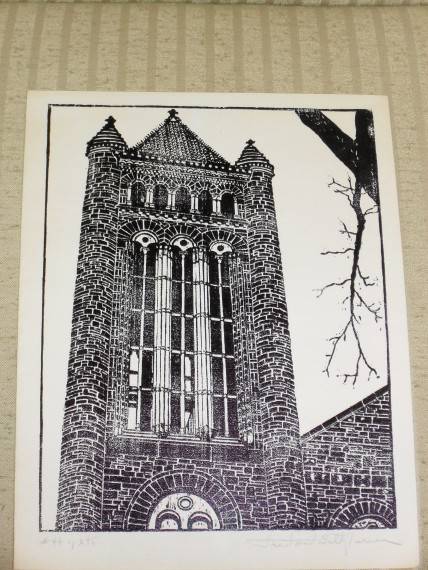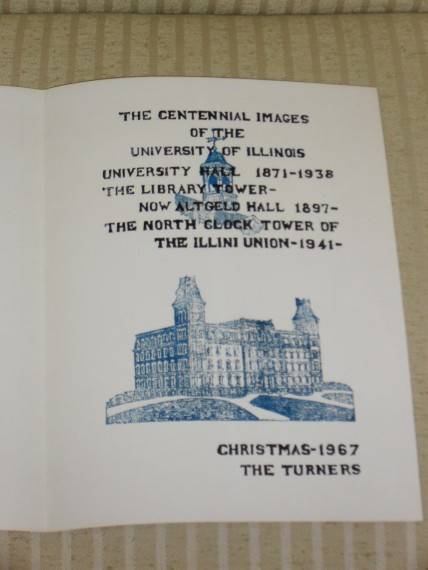 The Champaign County Historical Museum currently has an intriguing exhibit titled “Illinois History Through Woodblock Prints,” the backstory of which will likely interest history buffs. The exhibit displays a series of Christmas cards sent out every year between 1946 and 1974 by longtime University of Illinois dean Fred Turner and his wife Betty. Each card features a print that depicts a different historical structure in the state of Illinois. A few are of local structures — for example, the Cattle Bank where the Champaign County Historical Museum is now located — but most are of locations outside of the immediate area, like the Marcoupin County Court House in Carlinvile and the Hull House in Chicago.
The Champaign County Historical Museum currently has an intriguing exhibit titled “Illinois History Through Woodblock Prints,” the backstory of which will likely interest history buffs. The exhibit displays a series of Christmas cards sent out every year between 1946 and 1974 by longtime University of Illinois dean Fred Turner and his wife Betty. Each card features a print that depicts a different historical structure in the state of Illinois. A few are of local structures — for example, the Cattle Bank where the Champaign County Historical Museum is now located — but most are of locations outside of the immediate area, like the Marcoupin County Court House in Carlinvile and the Hull House in Chicago.
According to Sue Wood, a museum volunteer and one of the exhibit’s curators, Fred Turner was an academic whose interest in the subject arose primarily in the history of his own university. Later, though, Turner expanded his interests state-wide.
Turner would devote much of his spare time throughout the year to preparing his annual card. He began by taking photographs and make sketches of each site, then painstakingly type and paste the image onto a block of wood before cutting it out. The images and there accompanying text were then printed onto individual 9″ x 12″ cards — a slow, tricky process — with the assistance of Turner’s wife, Betty.
By his own admission, Turner got better at the process as the years went by. Turner used tulip wood for his blocks, and even the wood had some historical significance as it came from the trustees’ room at University Hall, an early UI building which was demolished in 1938 and stood near where the Illini Union is now. Turner obtained some shelving from the contractors who were destroying the building and used it for his cards for decades.
 The Turners would send out about 300 cards each year. Those on the receiving end of one of these cards appreciated the gesture and considered it an honor. “Once they saw what was happening, people wanted to be on the Christmas card list,” says Sue Wood.
The Turners would send out about 300 cards each year. Those on the receiving end of one of these cards appreciated the gesture and considered it an honor. “Once they saw what was happening, people wanted to be on the Christmas card list,” says Sue Wood.
After Turner’s death in 1974, the prints were donated to the Champaign County Historical Museum. The exhibit was on display at this year’s Boneyard Arts Festival, but for those who missed it, the prints can be viewed until September 27. The woodblocks themselves are housed at the University of Illinois Archives along with Dean Turner’s papers.
In my view, one of the most remarkable aspects of this exhibit is the consistency of effort from one year’s print to the next. It’s quite a feat to start an annual project during the aftermath of World War II and carry it on through the Eisenhower years into the Vietnam Conflict, not missing a single year. But then, Turner was clearly a person who stuck to things he started. Museum historian R.B. Bruce writes of Turner: “He graduated from Tuscola High School in 1918 and matriculated at the U of I that fall. Basically he never left.”
Turner earned a degree in Chemistry, and began work for the university at the position of Assistant Dean for Men. In 1932, the “assistant” part of the title was dropped and Turner became Dean of Men, earning a master’s degree in psychology and a PhD. in education along the way. He served as a dean until his retirement in 1966 and remained involved with the university in numerous capacities until his death in 1974. During his years at the UI, Turner piled up many honors, including having a building, fellowship, and academic conference named after him.
Turner must have spent many weekends combing Illinois looking for bridges, court houses, churches, and other structures to photograph. According to R.B. Wood, an initial inspiration was a car trip Turner took from East St. Louis to Chester, Illinois. Turner was “particularly taken by the 1756 chapel at Ft. Chartres, and in 1946 this subject became the first of Fred and Betty Turner’s woodblock Christmas cards of historic structures in Illinois.”
From there, I suppose it’s possible that Turner just had a register of historic places and methodically visited and photographed them, but I’m guessing that these prints are more a result of personal research, observation, and reflection. After the first three Christmas cards, Turner began including information on the sites, complete with historical asides. For instance, the inset for his 1962 Christmas card of The Pullman Company Clock Tower in Pullman, Ill., includes sections entitled “Town Development in the Age of Eclecticism” and “What is Left.” Turner acknowledges the help of a Pullman citizen, one “Mr. John B. Siewers, Jr. of the Pullman Trust and Savings Bank,” in helping him locate an obscure book about the community. So Turner clearly went to great lengths to make each card — and his collection as a whole — an engaging, historical read. To me, the visual impact, geographic variety, and effective research behind the prints demonstrate Turner’s inquisitive nature concerning the region he lived.
The print that most caught my eye is one of The Dockers Riverside Hotel in Shawneetown. I went to college in southern Illinois and have a fondness for that region. Sue Wood’s favorite is of the Altgeld Hall Tower on the UI campus, which isn’t surprising given that Wood has been a chime ringer in the tower since 1971. (When I talked to her she had just returned from giving a noon concert.) She feels the exhibit is worth seeing since “it’s reflective of the total interest that an important person in the history of the UI took in the state.”
——
The Champaign County Historical Museum is located at located at 102 E. University in Champaign and is open between noon and 5 p.m. on Saturdays and Sundays.
Like this article? May we recommend:








